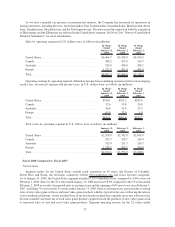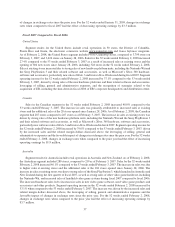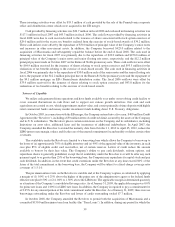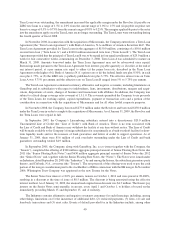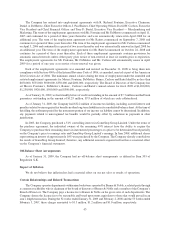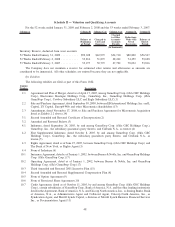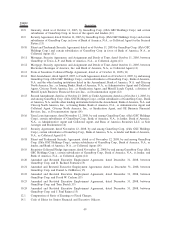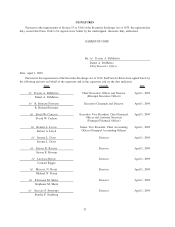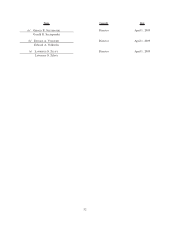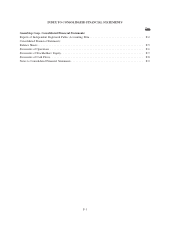GameStop 2008 Annual Report Download - page 59
Download and view the complete annual report
Please find page 59 of the 2008 GameStop annual report below. You can navigate through the pages in the report by either clicking on the pages listed below, or by using the keyword search tool below to find specific information within the annual report.
In May 2005, the Company entered into an arrangement with Barnes & Noble under which
www.gamestop.com became the exclusive specialty video game retailer listed on www.bn.com, Barnes & Noble’s
e-commerce site. Under the terms of this agreement, the Company pays a fee to Barnes & Noble for sales of video
game or PC entertainment products sold through www.bn.com. The fee paid to Barnes & Noble in connection with
this arrangement was $0.5 million, $0.4 million and $0.3 million for the 52 weeks ended January 31, 2009, 52 weeks
ended February 2, 2008 and the 53 weeks ended February 3, 2007, respectively.
Until June 2005, GameStop participated in Barnes & Noble’s workers’ compensation, property and general
liability insurance programs. The costs incurred by Barnes & Noble under these programs were allocated to
GameStop based upon total payroll expense, property and equipment, and insurance claim history of GameStop.
Management deemed the allocation methodology to be reasonable. Although the Company secured its own
insurance coverage, costs will likely continue to be incurred by Barnes & Noble on insurance claims which were
incurred under its programs prior to June 2005 and any such costs applicable to insurance claims against GameStop
will be allocated to the Company. During the 52 weeks ended January 31, 2009 and February 2, 2008 and the
53 weeks ended February 3, 2007, these allocated charges amounted to $0.2 million, $0.3 million and $0.8 million,
respectively.
The Company had a promissory note in the favor of Barnes & Noble in the principal amount of $74.0 million,
in connection with the repurchase of the Company’s common stock held by Barnes & Noble in October 2004. The
note was unsecured and bore interest at 5.5% per annum, payable with each principal installment. Scheduled
principal payments of $12.2 million were made in October 2006 and October 2007 and the note has been satisfied in
full. Interest expense on the promissory note for the 52 weeks ended February 2, 2008 and the 53 weeks ended
February 3, 2007 totaled $0.4 million and $1.1 million, respectively.
Recent Accounting Standards and Pronouncements
In March 2008, the FASB issued Statement of Financial Accounting Standards No. 161, Disclosures about
Derivative Instruments and Hedging Activities — an amendment of FASB Statement No. 133 (“SFAS 161”).
SFAS 161 requires enhanced disclosures about how and why an entity uses derivative instruments, how derivative
instruments and related hedged items are accounted for and their effect on an entity’s financial position, financial
performance, and cash flows. SFAS 161 is effective for the Company on February 1, 2009. The Company is
currently evaluating the impact that the adoption of SFAS 161 will have on its consolidated financial statements.
In December 2007, the FASB issued Statement of Financial Accounting Standards No. 141 (revised 2007),
Business Combinations (“SFAS 141(R)”). SFAS 141(R) amends the principles and requirements for how an
acquirer recognizes and measures in its financial statements the identifiable assets acquired, the liabilities assumed,
any noncontrolling interest in the acquiree and the goodwill acquired. SFAS 141(R) also establishes disclosure
requirements to enable the evaluation of the nature and financial effects of the business combination. SFAS 141(R)
is effective for the Company on February 1, 2009, and the Company will apply SFAS 141(R) prospectively to all
business combinations subsequent to the effective date.
In December 2007, the FASB issued Statement of Financial Accounting Standards No. 160, Noncontrolling
Interests in Consolidated Financial Statements — an amendment of Accounting Research Bulletin No. 51
(“SFAS 160”). SFAS 160 establishes accounting and reporting standards for the noncontrolling interest in a
subsidiary and for the deconsolidation of a subsidiary. SFAS 160 also establishes disclosure requirements that
clearly identify and distinguish between the controlling and noncontrolling interests and requires the separate
disclosure of income attributable to controlling and noncontrolling interests. SFAS 160 became effective for the
Company on February 1, 2009. The Company is currently evaluating the impact that the adoption of SFAS 160 will
have on its consolidated financial statements.
In September 2006, the FASB issued Statement of Financial Accounting Standards No. 157, Fair Value
Measurements (“SFAS 157”), which defines fair value, establishes a framework for measuring fair value, and
expands disclosures about fair value measurements. SFAS 157 applies to other accounting pronouncements that
require or permit fair value measurements. The Company adopted SFAS 157 on February 3, 2008 as required for its
financial assets and liabilities. However, in February 2008, the FASB released a FASB Staff Position, FSP
FAS 157-2, Effective Date of FASB Statement No. 157, which delayed the effective date of SFAS 157 for all non-
44



